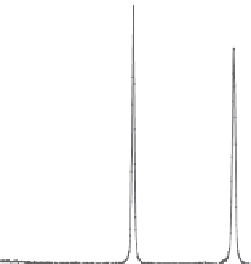Environmental Engineering Reference
In-Depth Information
12.1.1 Perovskite-type Structure compounds: natao
3
, la : natao
3
and Sm : natao
3
One of the semiconductors mostly used in photocatalysis is the perovskite-type oxide NaTaO
3
because it demonstrated excellent
results as a catalyst for hydrogen production from water splitting reaction and for degradation of organic compounds [4, 7, 11].
This material has been considered as a catalyst due to its ability to carry out photoabsorption and charge separation, its mobility,
as well as its use in reduction-oxidation (redox) reactions in the photocatalytic system. In general, NaTaO
3
presents a cubic
framework where Ta-O-Ta bonds form an angle close to 180° (Fig. 12.1).
In our research group, NaTaO
3
, La : NaTaO
3
, and Sm : NaTaO
3
semiconductors have been synthesized by the sol-gel method
[12, 13]. The incorporation of La and Sm into NaTaO
3
reduces the mobility of electrons and holes to avoid the recombination
and retards the crystallization of NaTaO
3
, provoking the formation of NaTaO
3
nanoparticles with high specific surface area.
Figure 12.2 shows the X-ray diffraction (XRd) patterns of NaTaO
3
doped with La. This material was prepared by the sol-gel
method. On the basis of observations, its patterns agreed well with the file pattern reported in the Joint Committee on Power
diffraction File (JCPdF) database.
The material prepared by the sol-gel method was obtained in nanoparticle size, and as can be seen in the TeM micrographs,
particles tend to agglomerate each other, increasing their size to greater than 200 nm (Fig. 12.3).
The specific surface area and the energy band gap of NaTaO
3
perovskite-type compounds revealed interesting photocatalytic
applications (Table 12.1).
figure 12.1
Crystal structure of NaTaO
3
.
La-NaTaO
3
sol-gel pH 7
NaTaO
3
(JCPD 89-8061)
800° C, 28 h
600° C, 28 h
400° C, 6h
11
20
30
40
50
60
2θ
figure 12.2
X-ray diffraction (XRd) patterns of La : NaTaO
3
synthesized by the sol-gel method.




































































































































































































































